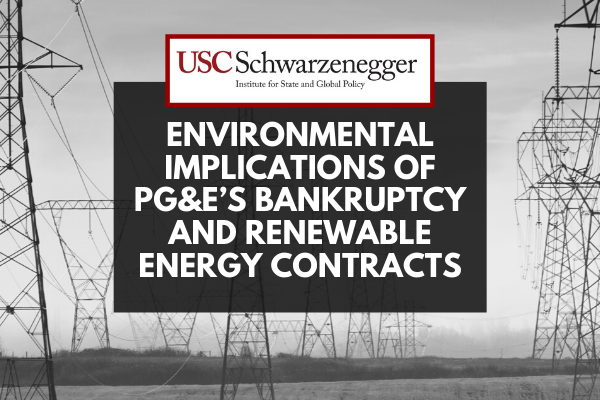Environmental Implications of PG&E’s Bankruptcy and Renewable Energy Contracts
Mark Bernstein, Ph.D.
Jonathan Eyer, Ph.D.
Jonathan Gordon
Summary and Introduction
In January 2019, Pacific Gas and Electric (PG&E) declared bankruptcy. As California’s largest utility – serving over 16 million people, PG&E faced over $30 billion in liability for at least 17 fires that ravaged California in 2017 as well as the 2018 Camp Fire that killed 85 people. While utilities in California have long been mandated to lead the march towards the state’s ambitious renewable energy goals, the viability of achieving these goals was called into question in the PG&E bankruptcy. When we started this research there was considerable uncertainty about whether PG&E would be allowed to cancel their legacy renewable energy contracts and we were evaluating what the potential impacts could be if that were to occur. Ultimately, the renewable energy contracts were maintained in the PG&E reorganization plan approved by the courts and the State of California in June 2020. The conclusions from our analysis are still relevant and, in this paper, we describe how maintaining PG&E’s renewable energy contracts reaffirms the state’s leadership role in climate change and sends a positive signal for new technology development and the ability to achieve the state’s renewable energy and carbon reduction goals.
PG&E holds 387 power purchase agreements (PPAs) with solar, wind, and other renewable energy providers. These contracts were signed in the early 2000s and, at the time, were stateof-the-art projects, but solar costs have fallen in subsequent years so PG&E is purchasing from these projects at rates substantially higher than could be procured from new solar developments. Many contracts that were signed in the late 2000’s or early 2010’s carried contract costs that exceeded $100/MWh. New industrial scale projects may convey a cost below $50/MWh, by contrast. The PG&E bankruptcy opened the potential that these contracts could be renegotiated or canceled in order for PG&E to reduce their energy procurement costs.
The decision to not abrogate the legacy PPAs is an important one for California’s climate goals and sends a positive signal about the stability of utilities that impacts California’s climate and energy goals in two ways. First, while solar is now a relatively developed industry and if the contracts were canceled negative impacts on that industry would have likely been minimal and short-lived, there could have been a more substantial adverse effect on other emerging clean energy sectors that California is seeking to support. New investments in emerging sectors, like electricity storage, will require confidence that long-lasting contracts will be upheld and abrogation of the PPAs would have made innovators in other sectors question whether their contracts could be canceled when a utility suffers another disaster.
Second, California is viewed nationally and globally as an environmental leader. Canceling of the PPAs could have reduced California’s role as a global leader, limiting its ability to influence the path of emissions reductions. By remaining committed to the PPAs, California maintains its dedication to climate action that will help provide new innovators confidence in their investments and preserve California’s role in the global climate conversation.


